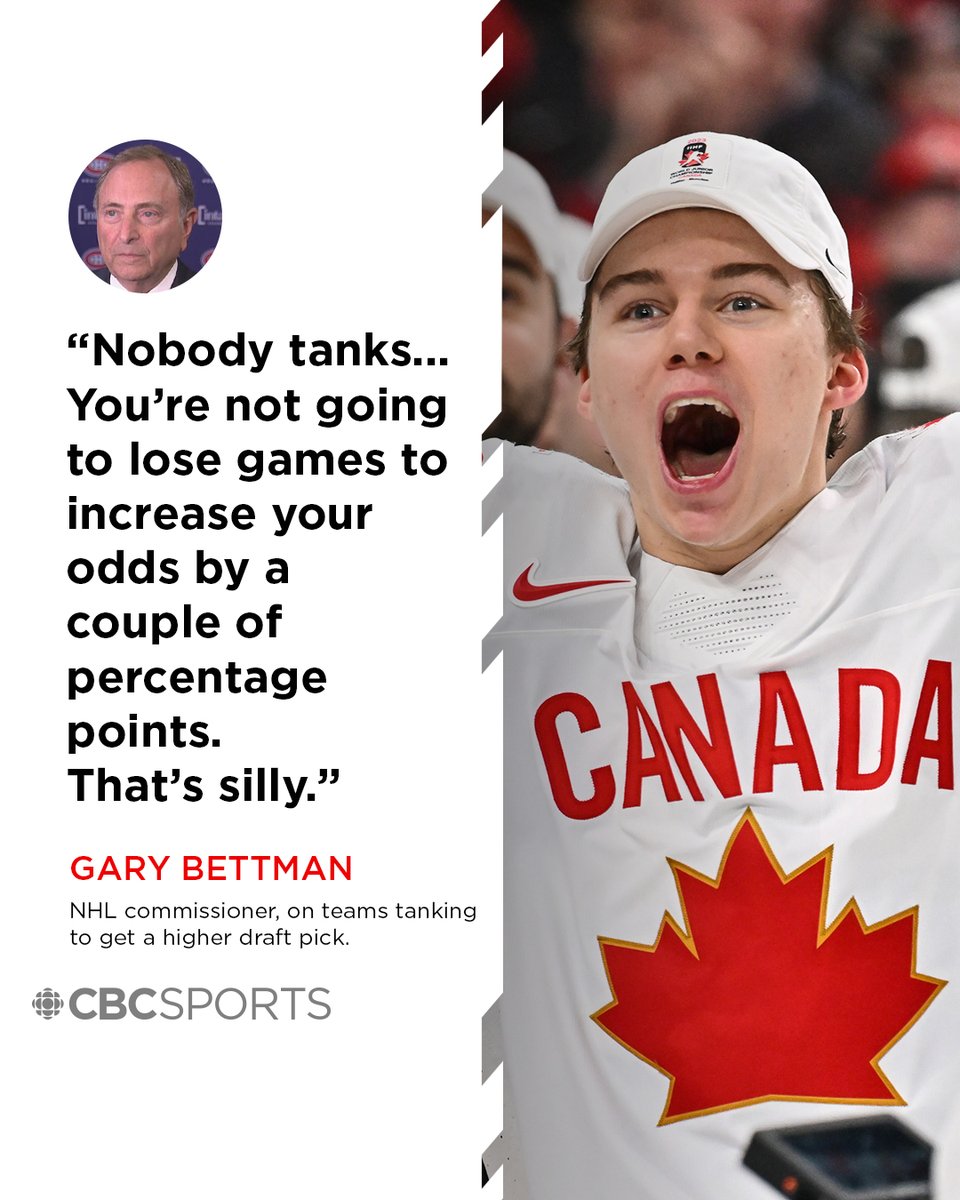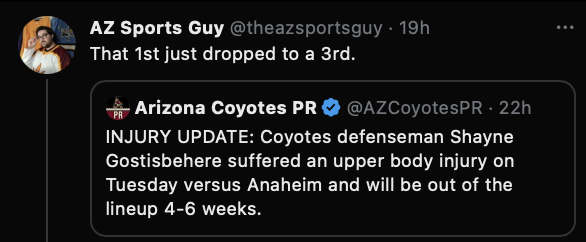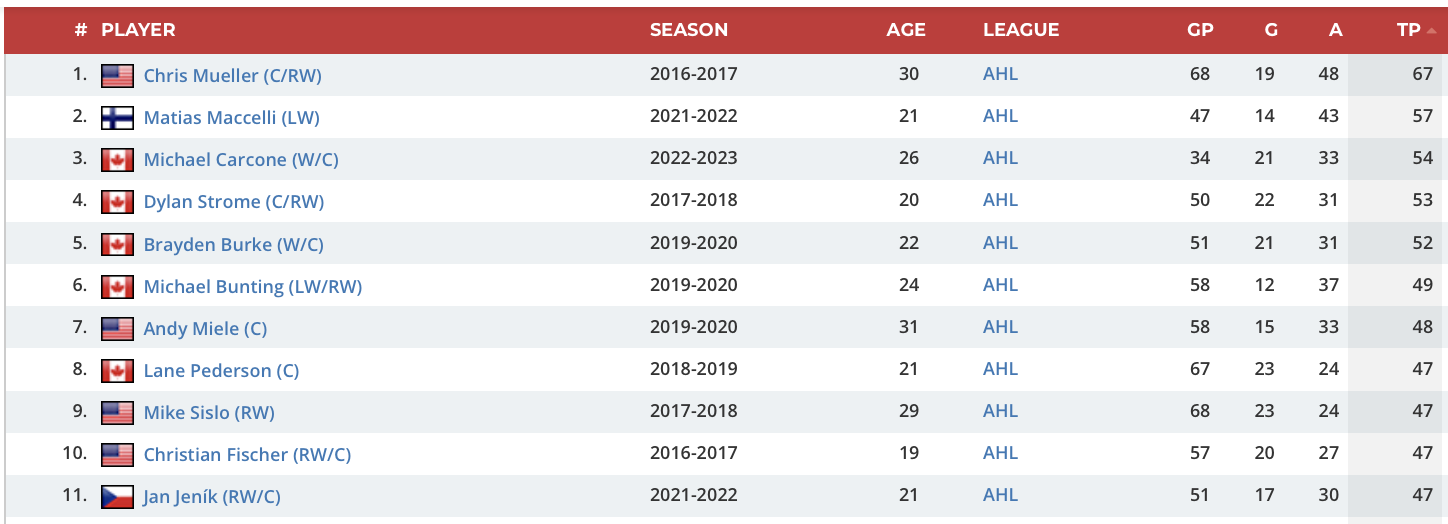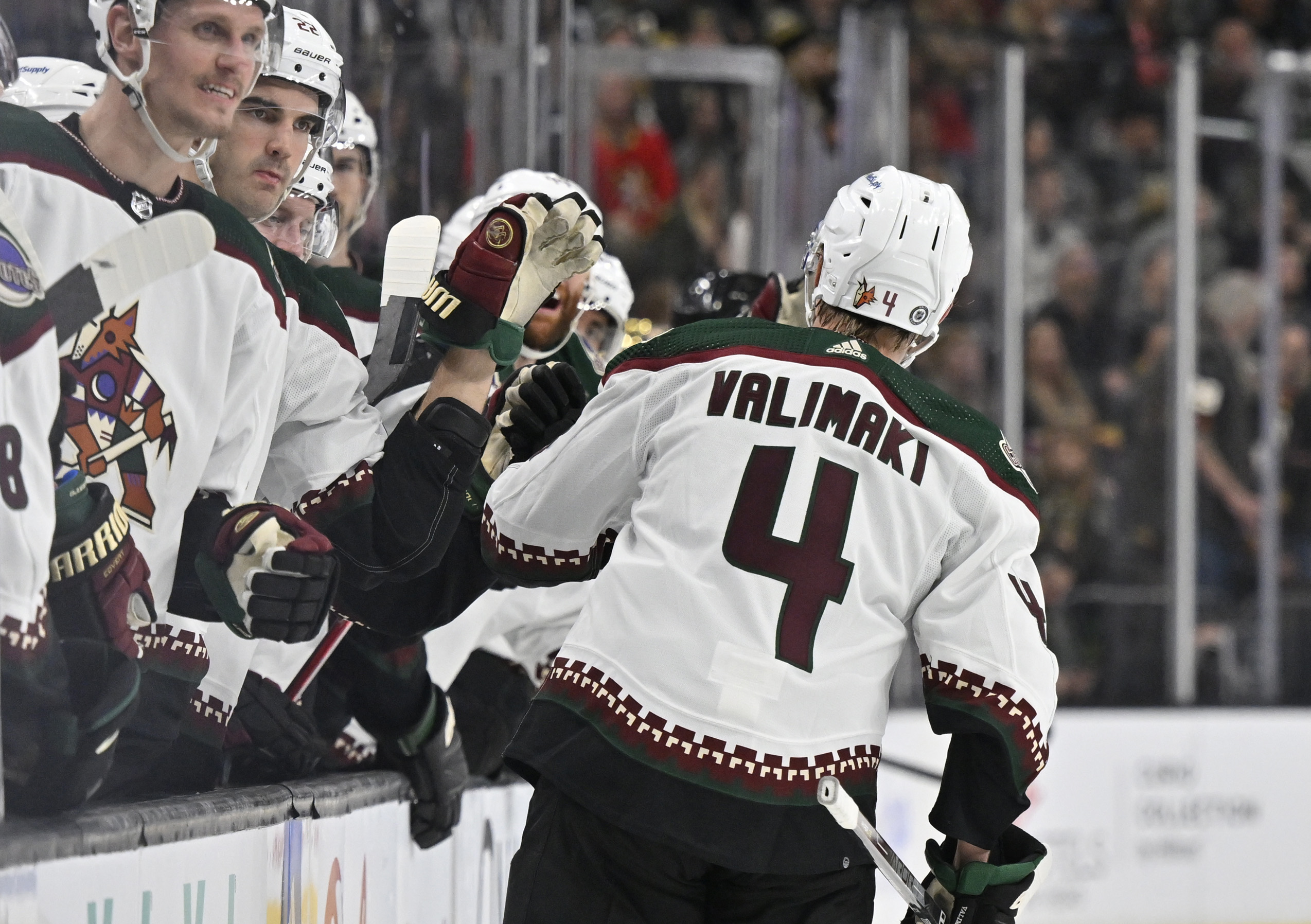© 2025 ALLCITY Network Inc.
All rights reserved.

On Jan. 5, the Coyotes were 11 points ahead of the Chicago Blackhawks, seven points ahead of the Columbus Blue Jackets, five points ahead of the Anaheim Ducks, tied with the San José Sharks, and two points behind the Montréal Canadiens in the NHL standings.
The odds of landing Connor Bedard — or even Adam Fantilli or Leo Carlsson — at the 2023 NHL Draft looked long.
Three weeks later, as the Coyotes head into their final game before the All-Star break, they trail the Canadiens by seven points, the Sharks by two points, they lead the Ducks by two points, the Blackhawks by three and the Blue Jackets by four.
Whatever happens in Anaheim on Saturday, or in the Jackets’, Sharks’ or Hawks’ games this weekend, the Coyotes are very much in the running for the NHL’s worst overall record, the best odds at landing Bedard, and the only standings spot that carries a guarantee of landing Bedard, Fantilli or Carlsson.
NHL commissioner Gary Bettman took some flak for suggesting that teams are not focused on Bedard as they step onto the ice every night.
It was convenient fodder for the mindless shock jocks, podcast hosts and Bettman haters (pro sports commissioners are an unpopular lot), but Bettman is right about coaches and players. They don’t tank. They play to win every night. They bristle when the topic is raised.
That fact was underscored by Thursday’s wild results when the Coyotes beat the Blues 5-0, but did not lose any ground in the tank race because Chicago won in Calgary, Anaheim won in Colorado, and Columbus rallied to win in Edmonton the night before.
Organizations do tank, however, and that is driven by management and ownership’s view of the roster and the future. Coaches and players must focus on the present. GMs have to focus on the present and the future.
Coyotes GM Bill Armstrong has been candid about the franchise’s plans to acquire draft assets and then draft as high and as often as possible. Following a stretch in which the Coyotes have lost 12 of 15 games in regulation, they are back in contention to achieve their primary directive.
I am going to take a few days off during the All-Star break but I will still publish my mailbag on Monday. Before I sign off for a few days, here’s a collection of quick notes for an All-Star break edition of the Neutral Zone.

Coyotes trade talk
If you missed Bill Armstrong’s in-studio visit with PHNX Sports on Monday, it’s worth watching. We covered a lot of ground in the hour-long show.
One of the topics we touched on was the state of the market with five weeks remaining before the March 3 NHL trade deadline.
Here’s what he had to say: “There’s a lot of teams that don’t know what they’re doing inside the market. They’re not sure if they’re buyers or sellers. I think they’re keeping their hand in both and it’s probably confusing the market a little bit.”
Nothing spurs action from GMs quite like a deadline. When teams return from the All-Star break on Feb. 6, the trade deadline will be 25 days away so we are fast approaching the time for action.
But before Saturday’s games, there were five Eastern Conference teams outside the playoff picture, yet within eight points of the final wild card. In the Western Conference, there were three teams outside the playoff picture, but within six points of the final wild card.
Some GMs aren’t being realistic about their teams’ chances, but others don’t know what their teams are just yet so they have put those trade plans on hold, not wanting to kill the potential for a playoff run. The next few weeks will provide more clarity.
Armstrong has tried to be transparent with his long list of potential trade chips, including Jakob Chychrun, Shayne Gostisbehere, Nick Ritchie, Josh Brown, Nick Bjugstad, and maybe guys such as Christian Fischer, Karel Vejmelka and Troy Stecher.
Most of those players have understood the situation since the season began.
“Hopefully it’s not too much of a distraction, but it is part of the process that we’re going through,” Armstrong said.

The Ghost prognosis
Shayne Gostisbehere suffered an upper-body injury in a loss to the Ducks on Tuesday that will sideline him for four to six weeks. The injury occurred 5½ weeks before the March 3 trade deadline.
There has been a lot of hand wringing by Coyotes fans on the potential impact of this injury on Gostisbehere’s trade value. There are even those suggesting that Armstrong should protect his other assets ahead of the deadline to avoid further injuries.


Let’s put those misconceptions to bed.
The Coyotes are not concerned about the severity of Gostisbehere’s injury. They are certain that he is going to be fine and that he will be healthy by the trade deadline.
Beyond that important fact, other teams know exactly who Shayne Gostisbehere is as a player. They have scouted him enough to understand his strengths and flaws. A dozen more games before the trade deadline for a guy who has an established track record aren’t going to matter.
As for the notion that Armstrong should either sit players such as Chychrun for the next month or trade them right now, um, what? You don’t sit a player for that long a stretch. The player wouldn’t stand for it, the coaching staff wouldn’t stand for it and the NHLPA certainly wouldn’t stand for it.
And you don’t trade a player when the right deal is not there. You wait for urgency to impact the market. You wait for the right deal.
Injuries are part of the risk inherent in being a GM. You live with that reality.

Liam O’Brien nearing return to Coyotes
Liam O’Brien skated before the team on Thursday morning. He had a stick in his hands and he was passing and shooting.
That’s a good sign for a guy who has not played since suffering a hand injury on Dec. 16 against the New York Islanders.
Coach André Tourigny said that O’Brien is targeting a mid-February return to the lineup.
“Second week of February at the earliest,” said Tourigny, noting the initial timeline of eight to 12 weeks. “It’s coming. We’re happy about where it’s heading.”
Coyotes recall candidates
In the wake of the Gostisbehere injury, the Coyotes did not plan to recall anybody from Tucson before the game on Saturday in Anaheim; their last before the break. We’ll see what happens after the break. The Coyotes have a three-game road trip through Chicago, St. Louis and Nashville from February 10-13. It’s hard to imagine them traveling with six defensemen and 12 forwards.
If you’re looking at potential recall candidates on the back end, start with Victor Söderström, Vladislav Kolyachonok and Ronald Knot. The organization is happy with the way they are playing and would like to give them a look at the NHL level.
Up front, Nathan Smith and Ben McCartney are a couple of candidates. Michael Carcone is always an option, but in the recent six-game stint when he was with the Coyotes from Jan. 3-22, the Roadrunners managed two goals or fewer in four of eight games.
Carcone leads the AHL with 54 points in 34 games. That is already the third-best single-season point total in Roadrunners history and Carcone is on track to set the record.

Dylan Guenther decision date looms
When Dylan Guenther returned from the World Junior Championship, GM Bill Armstrong wanted him to focus solely on playing.
There would be no talk of keeping Guenther‘s games on the active roster under 40 so that he would not accrue a season toward unrestricted free agency.
There would be no talk of a two-week conditioning stint in Tucson.
There would be no talk of returning him to the Western Hockey League where he might get the chance to compete for a playoff team, and possibly the Memorial Cup that he missed out on last season due to an injury.
That does not mean, however, that some of those options are off the table.
The key for Guenther was to see how he would perform on a nightly basis in the lineup. Since his return, it has been a mixed bag. There have been nights where he has looked strong, driven offense and even scored goals. There have been nights where he looks like he is swimming in water above his head.
The date for the Coyotes to make a decision on Guenther is their game against the Blackhawks in Chicago on Feb. 10. That game would mark Guenther‘s 39th game on the active NHL roster. If he is on the roster for a 40th game he would accrue one season toward unrestricted free agency.
Guenther would have to return to the WHL by the NHL trade deadline (March 3) in order to be playoff eligible, so that is another date to keep in mind.
In an ironic twist, the Seattle Thunderbirds have already traded for Guenther‘s rights from the Edmonton Oil Kings. It was Seattle that injured Guenther (and other Oil Kings) in last season’s WHL final, won by Edmonton. Those injuries played a role in Edmonton coming up short in the Memorial Cup.
Seattle currently leads the WHL‘s Western Conference and is a strong candidate to advance to the Memorial Cup, so keep an eye on Guenther’s overall performance in February. It’s fun to imagine Guenther squaring off with fellow Coyotes prospect Conor Geekie and the Winnipeg Ice (they currently lead the Eastern Conference in points percentage) in the WHL final.
The Coyotes’ stupid schedule
When the Coyotes face the Ducks in Anaheim on Saturday, it will conclude their stretch of 15 games in 26 days.
The difficulty of Arizona‘s schedule has clearly been compounded by their arena situation. They can never settle in for a long homestand due to scheduling conflicts with ASU, which owns Mullett Arena.
That said, there are other teams that have faced ridiculous schedules this season as well. When I spoke to Winnipeg Jets coach Rick Bowness recently, his team was in the midst of 14 games in 25 days.
Part of the reason for the condensed schedule is the NHLPA‘s insistence on a weeklong break for the All-Star game, but the NHL has made some mind-blowing decisions regarding the schedule, whether it’s compacting a stretch of games and then having a team off for three or four days randomly, its apparent misunderstanding of geography when designing some road trips, or its resistance to the idea of playing multi-game series in one city to alleviate the wear and tear of travel on players’ bodies.
It is impossible to draw a direct link between the increase in injuries over the past few seasons and the condensed schedule. The game keeps getting faster, the players keep getting bigger and players are becoming more and more aware of the need to rest their bodies when they are hurt, rather than playing through injuries. In essence, they are protecting their greatest financial asset; their body.
That said, figures from Nathan Currier of mangameslost.com show a marked increase in man-games lost to injury over the past three seasons when compared to the three previous seasons at about the same point in the seasons.
|
NHL season |
Total man-games lost to injury |
|
2022-23 |
5,708 |
|
2021-22 |
6,443 |
|
2020-21 |
5,218 |
|
2019-20 |
3,487 |
|
2018-19 |
3,861 |
|
2017-18 |
3,148 |
Aside from that obvious concern, Bowness had another.
“What about the quality of the product?” he asked. “When does that come into play? We’re charging more and more for tickets. What about the quality of play for the people who pay the big bucks to see the games? Players are exhausted and beat up. They can’t play at the same level with this kind of schedule.”

Confusing Coyotes
Here’s a stat that’s hard to figure. The Coyotes are an NHL-worst 4-14-3 against the Western Conference. Every other team has at least eight wins against the West.
On the flip side: The Coyotes are 12-14-2 against the stronger Eastern Conference; 4-1 against its top 3 teams (Boston, Carolina, Toronto).
Arizona has just four games left against the East: 29 vs. the West.

Making sense of Rick Tocchet’s decision
A few of you have asked me for my thoughts on the Canucks’ decision to hire Rick Tocchet as their next coach after firing Bruce Boudreau. I do find it amusing that the same media and fans who were torching Boudreau’s performance in Vancouver are now clutching their pearls over his drawn-out and emotional dismissal.
I agree that it’s not a good look for the organization, but nobody knows what sort of negotiations were going on behind the scenes with Tocchet, and how those talks might have drawn out the process and contributed to Boudreau’s flapping-in-the-wind final weeks.
It was hard to watch Boudreau’s final days, but getting fired always sucks, whether you know it’s coming or not. That has nothing to do with the greatest issue in Vancouver; one that neither the franchise nor Tocchet seems ready to acknowledge.
The Canucks are not a good team. Further, there isn’t enough talent on the roster to make them a good team. The 2020 postseason run (two series wins) was an anomaly in more ways than its unique nature in the playoff bubble in Edmonton.
Elias Pettersson is a stud and Andrei Kuzmenko looks like a promising young player, but Brock Boeser and Bo Horvat could be traded and Quinn Hughes, for all his otherworldly offensive talents, can’t defend well in his own zone, which is kind of what is required in the playoffs when the games get gritty, direct and physical.
What’s more, the Canucks’ cap situation — remember they have Oliver Ekman-Larsson under contract through 2026-27 at a cap hit of $7.26 million — won’t make it easy to dig out anytime soon.
So why did Tocchet take his third head coaching job in a third location with major issues (albeit, of a different type in Vancouver). Why didn’t he learn from his past two experiences in Tampa and Arizona? Why would he leave a job that was paying him in the neighborhood of $1 million for one day of work per week for the pressure cooker of NHL coaching — in one of the hottest pressure cooker markets in the league? Why would he want to coach OEL again after their relationship fractured more than he was apparently willing to admit at his introductory news conference?
Here’s why. Because it’s in his blood. He has the ego that he needs to have as a competitor to succeed; a self-confidence that makes him believe that he can fix this mess. He also loves coaching more than sitting in a broadcast booth because he is that competitor; an alpha male who wants to win. Coaching is in his DNA, just as it was in Dave Tippett’s DNA to leave an influential executive role with the Seattle Kraken to coach the deeply flawed Edmonton Oilers.
You can’t ask Tocchet to change what is in his very nature. The entire time he was at Turner, he was considering other offers. He missed the juice.
I genuinely enjoyed covering Tocchet. He’s personable, he’s insightful, he’s funny, he’d do anything for his friends, and he studies the game more than anyone realizes; down to the microscopic minutiae.
I wish him luck in Vancouver. He’s going to need it in yet another situation that is miles from ideal.

Validation for Juuso Välimäki
When Juuso Välimäki arrived in Arizona in October off waivers from Calgary, all he was seeking was opportunity. He never felt that he would get that opportunity with old-school coach Darryl Sutter, who made news recently with this reaction to rookie Jakob Pelletier’s NHL debut.
Välimäki got a form of validation on Tuesday when the Coyotes signed him to a one-year $1 million contract extension.
“We told him, ‘We want you back,’ so we started the process and the number was good for both sides,” GM Bill Armstrong said. “We told him, ‘We want to give you another year with a big summer of training. We like what you do, we like your energy and everything that you bring.'”
Välimäki is averaging 14:56 of ice time in Arizona. That’s about 30 seconds less than he averaged in 82 games in Calgary, but he is getting power-play time that he was not getting in Calgary and he is getting the opportunity to be more offensive, whether that’s with the puck on his stick or in offensive situations. That has led to more self-confidence.
“If I’m being honest, there were times in the past when I didn’t have it at all and it’s very hard to play when you don’t have confidence,” he said. “All of the sudden, you get in and you play well and you play another game and it kind of snowballs and you have it back. I don’t ever want to lose it again.
“I just feel comfortable here and want to be here and do everything in my power to help his team win and keep growing as a player as a person.”
Here’s more insight from Välimäki in this short video clip.
Top photo of the Ducks and Coyotes via Getty Images
Follow Craig Morgan on Twitter
Comments
Share your thoughts
Join the conversation



